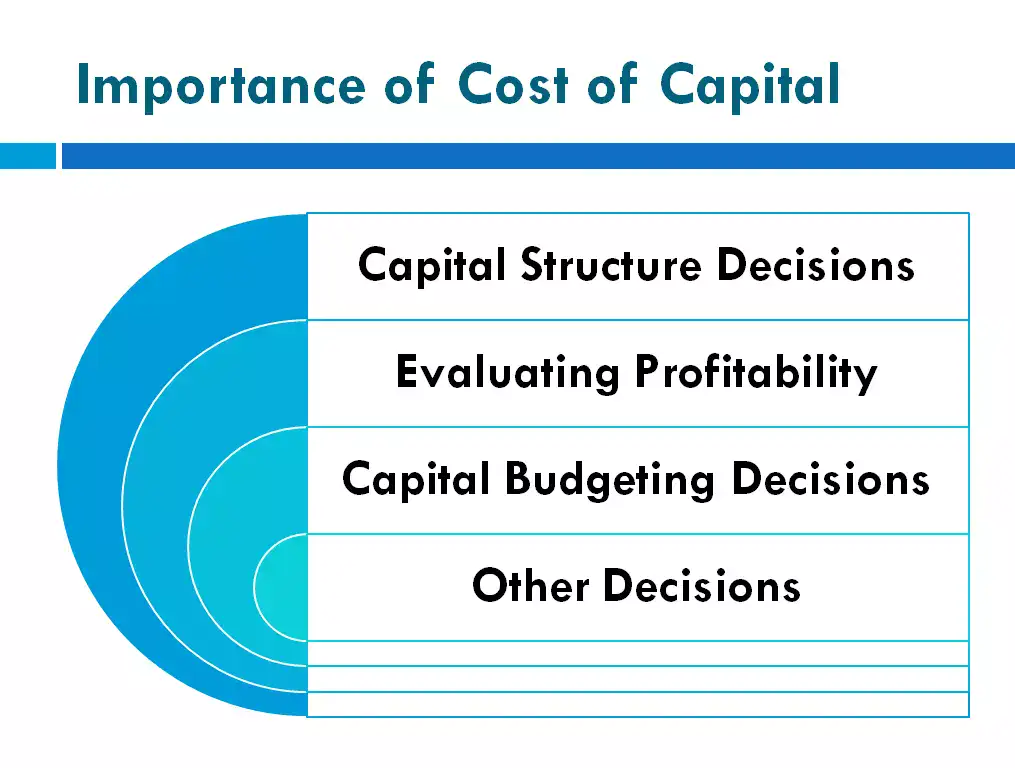Table of Contents:-
- Cost of Capital Meaning
- What is cost of capital?
- Characteristics of Cost of Capital
- Importance of Cost of Capital
- Features of Cost of Capital
- Factors Affecting Cost of Capital
Cost of Capital Meaning
The cost of capital refers to the minimum rate of return that a company must achieve on its investments to ensure that the market value of its equity shares either increases or remains at the same level. This statement aligns with every company’s objective of maximizing wealth for its shareholders.
Wealth Maximisation for the shareholders of a company is feasible only when the projects financed by the company (shareholders’ money) generate revenues at a rate equal to or more than the rate expected by the shareholders. In case the company is unable to earn the expected rate of return, the possibility of a decrease in the market value of the company’s shares cannot be ruled out, which ultimately may result in the erosion of the shareholders’ wealth.
What is cost of capital?
Some of the eminent authorities on the subject have defined ‘Cost of Capital’ as described below:
According to James C Van Horne, “A cut-off rate for the allocation of capital to investments of project. It is the rate of return on a project that will leave unchanged the market price of the stock”.
Solomon Ezra states, “Cost of Capital is the minimum required rate of earning or the cut-off rate of capital expenditures”.
According to Hampton, John J., “The rate of return the firm requires from investment to increase the value of the firm in the marketplace”.
In simple terms, the cost of capital refers to the minimum rate of return that investors expect from a business’s projects. This metric is important for determining the financial viability of investments.
The term “Cost of Capital” for an investment is also referred to as the “Minimum Required Rate of Return,” “Opportunity Cost,” or “Discount Rate” (also known as the “Interest Rate”).
Characteristics of Cost of Capital
The cost of capital is characterised by the following fundamental features:
1) Minimum Rate of Return: Cost of capital indicates the minimum rate of return, which is needed for maintaining the market value of a company’s equity shares.
2) Consideration of Risk Premium: The risk factor is taken care of during the computation of ‘Cost of Capital’, which is likely to be high if the numbers and degree of risks increase. In other words, the Cost of Capital is directly proportional to the number/degree of risks involved. The concept will be clearer with the following formula:
K = R + F,
Where, K = Cost of a required return,
R = Risk-free rate, and
F = Risk premium rate.
3) Not Necessarily a Cash Cost: The cost of capital, which a company is required to pay, may not be in the form of cash every time. Factually, it is indicative of the expectation of the company’s shareholders about returns from their investment.
In brief, the cost of capital to a company is equal to the equilibrium rate of return demanded by investors in the capital market for securities at a given degree of risk. The equilibrium Rate of Return is an interest rate at which the demand for money and supply of money is equal.
Related Articles:
- nature of business meaning
- nature of international business
- scope of international marketing
- determinants of economic development
- nature of capital budgeting
- nature of international marketing
Features of Cost of Control
Features of cost of control are as follows:
1. It is the minimum required rate of return to offset the effect of risk associated with business and to maintain profitability to maximise the wealth of shareholders.
2. Arranging sources of finance at the rate of return (called cost of capital), and allocating them to investments are the the sides of the same coin. The amount so invested must yield a return equal to or more than the rate at which sources are arranged to fund such investments.
3. Cost of capital has a role in maintaining the market value of the firm. The value of a firm will decline if it uses capital at a higher cost than the return on its assets.
4. Cost of capital involves implicit as well as explicit costs, therefore, it takes future risk and business risk into account.
5. The cost of capital refers to the rate of return that is generally expressed in the form of a percentage.
Importance of Cost of Capital
The cost of capital is very important for a company, as it plays a pivotal role in facilitating various decision making processes.

This can be observed by considering the following points:
1) Capital Structure Decisions: The objective of minimising the cost of capital needs to be kept in mind when planning an appropriate capital structure for a company. This would ensure a better market value for the company. The cost of financing is the determinant of the source of financing.
2) Evaluating Profitability: The profitability of a project depends upon the projected cost of the capital funds and the actual cost of the capital fund raised to finance the project. The performance of a project may be considered satisfactory if the project’s profitability is more than the projected and actual cost of capital.
3) Other Decisions: Decisions about the level of dividend distribution, working capital requirements etc., are affected directly by the cost of capital. Furthermore, the profitability of a project depends upon the cost of capital. The success or failure of the projects undertaken by a company is one of the bases of appraisal of the top management’s performance.
4) Capital Budgeting Decisions: ‘Cost of Capital’ may be considered one of the most essential basis on which capital budgeting is done. It is used as a rate for discounting cash inflows to assess the profitability of a project (under the DCF method). Furthermore, the minimum desired rate of return (projected) is compared with the actual rate of return under the Internal Rate of Return (IRR) method. This comparison allows for a comprehensive evaluation of investment performance.
Factors Affecting Cost of Capital
Cost of capital for a company is influenced by several factors (both external as well as internal for the company), some of which are as follows:
1) Market Conditions
Market conditions prevailing at a particular time are responsible for the risks associated with a financial instrument. The risk built into a financial instrument is directly proportional to the interest such instrument offers. Investors prefer to invest in a high-risk bearing instrument only when the rate of interest offered by it is relatively high and attractive enough to enter such a risky zone. Investors expect a higher interest rate with an increase in the risk associated with an instrument. Such an increase is termed a ‘Risk Premium’.
This causes the cost of funds to increase. Further, the marketability of an instrument and its price stability are equally significant. The marketability of a financial product at a relatively stable price may bring the investors’ expectation of the rate of return at a lower level, which may result in a lower cost of capital. In a contrary situation (i.e., poor marketability and the unstable market price of an instrument) investors’ expectations regarding the rate of interest would be higher and as a result, the cost of funds can be high.
2) General Economic Conditions
This factor is external to a company’s operational boundaries and beyond control. General conditions prevailing in the economy of a country are largely responsible for (a) “demand for’ and ‘supply of capital, and (b) inflationary expectations.
i) A high inflation rate affects the purchasing power of money and results in its reduced value. In such conditions, investors/shareholders expect a high rate of return as a part of compensation. The cost of capital in such situations tends to be high.
ii) In case of an increase in the demand for capital without a corresponding increase in the supply thereof the cost of capital (interest rate) would be high. In a reverse scenario, where the demand is weak and the supply is sufficient, the cost of capital is likely to be low.
3) Company’s Operations and Financing Decisions
Certain controversial decisions a company takes may also result in fluctuations or risks in the return. Risks arising out of such decisions may be categorised into two groups, viz.:
i) Business Risk, and
ii) Financial Risks.
Business Risks are the outcome of the company’s investment decisions and are characterised by variable returns on assets. Financial Risks are an increase in fluctuation in return to the equity shareholders, which is the result of the utilisation of debt and preference shares. With an increase in business and financial risks, investors’ expectation about the rate of return also increases, ultimately increasing the cost of capital. The reverse of the above phenomenon is also true, i.e., decreased financial and business risks are followed by a decrease in the cost of capital.
4) Amount of Financing
The cost of funds is directly proportional to the required quantum of funds. With the growing need for funds in a business, there is an increase in the weighted cost of capital. It may be due to many reasons, some of which are mentioned as follows:
i) With the increasing size of the issue, the need to reduce the price of the security/instrument also increases, which in turn results in the increased cost of capital.
ii) With the issue of more securities/instruments, the cost of selling securities (floatation cost) also tends to be more, which affects the cost of funds to the company.
iii) If a company approaches the market for an amount of capital, not in proportion to the strength of its capital or the size of the company, investors’ expectation of the rate of return increases, increasing the cost of capital.
iv) Institutional lenders express some reluctance to sanction huge amounts of funds in the absence of relevant documents about the company’s potential to ensure the appropriate application of borrowed funds into the business.
You May Also Like:-
Reference:
- https://dducollegedu.ac.in/Datafiles/cms/ecourse%20content/BMS-%20Cost%20of%20Capital.pdf
